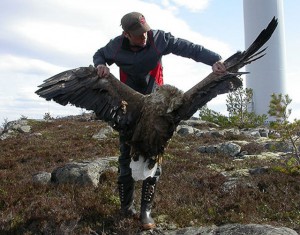“No animal says America like the bald eagle,” says Dan Ashe, Director of the U.S. Fish and Wildlife Service in a new statement calling recovery of the bald eagle “one of our greatest national conservation achievements.”
He is right about the importance of the bald eagle to Americans. It was adopted as our national emblem even before the Constitution, and has graced our national seals, coinage, currency, and documents ever since.
So when bald eagles nearly disappeared from the landscape, Americans were genuinely alarmed. It was a primary impetus for the Endangered Species Act, because by the 1960s fewer than 500 of the majestic birds were left in the lower 48 States. Until about ten years ago, I had never seen one soaring overhead. Today they are common, a truly resounding success story, with an estimated 150,000 bald eagles in the lower 48 States. Defenders of Wildlife estimates that there were at least 300,000 in the 1700s, but of course they could not possibly know that. Nevertheless, the species is no longer threatened with extinction and we should all be proud of that accomplishment.
Eagles are no longer on the endangered species list (one of the few species ever recovered and delisted), but they are still protected by the Bald and Golden Eagle Protection Act and the Migratory Bird Treaty Act. Those laws prohibit killing, selling or otherwise harming eagles, nests, or eggs without a permit, which private companies cannot get – unless they are wind generating companies.
 The Fish and Wildlife Service just issued a new rule which Mr. Ashe says will build on the success of eagle conservation – by authorizing thousands of eagles to be killed.
The Fish and Wildlife Service just issued a new rule which Mr. Ashe says will build on the success of eagle conservation – by authorizing thousands of eagles to be killed.
That irony almost reminds me of an old joke among Marines, who used to boast that a Marine Corps career provided the opportunity to travel the world, meet lots of new, different, exotic, and fascinating people – and kill them.
Mr. Ashe says this new eagle regulation seeks to balance new “green” energy development (i.e. wind turbines) with eagle conservation. That is a very difficult balance to strike, because it pits one major environmental goal against another. Which do we care most about, saving bald eagles or promoting wind energy? It is hard to have both in the same place at the same time, because windmills and birds do not peacefully coexist. If I like eagles and you like renewable energy, which of us is “greener?”
There is little doubt about which side of that scale the outgoing Administration weighs more heavily. The new rule, scheduled to go into effect just days before the inauguration, authorizes wind power companies to kill up to 4,200 eagles a year without any penalty. That is more than 4 times the current limit, authorized by President Obama earlier but apparently still not good enough. That’s because wind turbines are said to kill over 500 eagles a year already, and there are nowhere near as many wind turbines as this Administration wants. So, while they care about conserving eagles, they care more about replacing coal, oil and gas with wind as our primary energy source.
Anyone else faces a $5,000 fine and a year in prison for accidentally killing one eagle, twice that for accidentally killing two, and perhaps $250,000 in fines for continuing offenses. Yet wind companies are to be exempt from those rules, up to 4,200 eagles a year for up to 30 years. Consider that 4,200 eagles multiplied by 30 years would total 85 percent of all the bald eagles known to exist in the lower 48 today. Will they need to be put back on the endangered list?
To be fair, the new rule allows such eagle killing only if the companies minimize the risk by taking some other steps, like modernizing power poles to reduce electrocution. Also, all eagle deaths will have to be reported (today it is voluntary). Those requirements are useful, but cannot offset the giant wind machines’ impact on birds. Some environmental groups call them “Raptor-matics” and “Condor Cuisinarts.” The towers are as high as 30-story buildings; the rotors appear slow, but at their tips they can reach speeds of almost 200 mph.
Mr. Ashe’s explanation of the new rule’s purpose is simple and straightforward: to spur development of a pollution-free energy source intended to ease global warming, a cornerstone of President Obama’s energy plan.
So, which is the “greener” objective: renewable energy or wildlife conservation? Should we sacrifice the bald eagle to cover the landscape with windmills?
A version of this column originally appeared in the Grand Junction Daily Sentinel December 23,2016




Comments on this entry are closed.